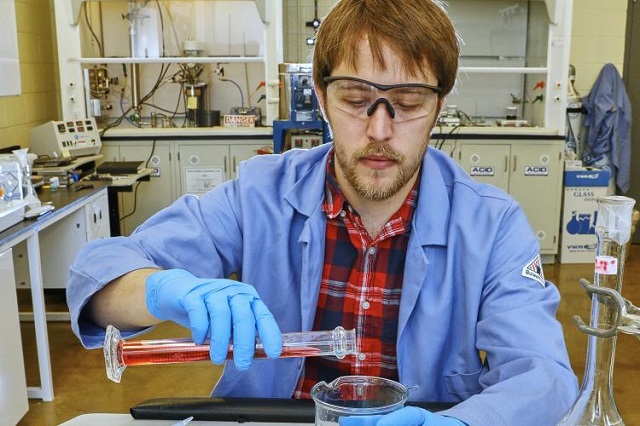 Researcher Andrew Binder and colleagues discovered that by mixing three components they could create an innovative catalyst that performs well at low temperatures without the use of precious metals.
Researcher Andrew Binder and colleagues discovered that by mixing three components they could create an innovative catalyst that performs well at low temperatures without the use of precious metals.
Researchers at the Department of Energy’s (DOE) Oak Ridge National Laboratory (ORNL) are developing a new low-cost catalyst, which could overcome one of the key obstacles still preventing automobile engines from running more cleanly and efficiently.
In vehicles, catalysts are used for cleansing its exhaust stream. When these catalysts are clogged by hydrocarbons, carbon monoxide and nitrogen oxides, the effectiveness of the catalysts are reduced. This clogging takes place due to the competition between these pollutants to acquire active sites on the catalyst’s surface.
ORNL’s low-cost catalyst composed of copper oxide, cobalt oxide and cerium oxide demonstrates considerable promise when tested in simulated exhaust streams.
Our catalyst potentially fixes the inhibition problem without precious metals and could help more efficient engines meet upcoming stricter emission regulations.
Todd Toops of ORNL’s Energy and Transportation Science Division
In previous studies, Andrew Binder and Sheng Dai, who are colleagues of Todd, had been trying to find out better oxidation activity by changing the composition of the three components of the catalyst under simple conditions.
In engines, gains in efficiency are associated with lower exhaust temperatures. This factor creates additional problems as high temperatures enable conventional catalysts to perform with better efficiency. The biggest challenge is considered to be from hydrocarbons.
As we make engines more efficient, less wasted heat exits the engine into the exhaust system where catalysts clean up the pollutant emissions. The lower temperatures in the exhaust from the more efficient engines are lower than the typical operating range of catalysts, so we need innovations like this catalyst to lower the operating range and control the engine pollutants.
Jim Parks, a member of the Energy and Transportation Science Division
The researchers report encouraging findings from this study that would be important as “vehicles with internal combustion engines will likely remain a dominant fraction of the light-duty fleet in both hybrid and conventional drive-trains,” they added.
Toops, Binder, Dai and Parks conducted comprehensive tests to find out the optimum ratio of the combination of the three oxides - copper oxide, cobalt oxide and cerium oxide. The initial evaluation was performed at an atomic ratio of 1:5:5. Further, the team intends to conduct cost-benefit analyses and find out the feasibility of scaling up this new approach.
The study paper entitled, “Low Temperature CO Oxidation over Ternary Oxide with High Resistance to Hydrocarbon Inhibition,” has been published in the journal, Angewandte Chemie.
This study has been funded by the DOE’s Office of Energy Efficiency and Renewable Energy, Vehicle Technologies Program.
References